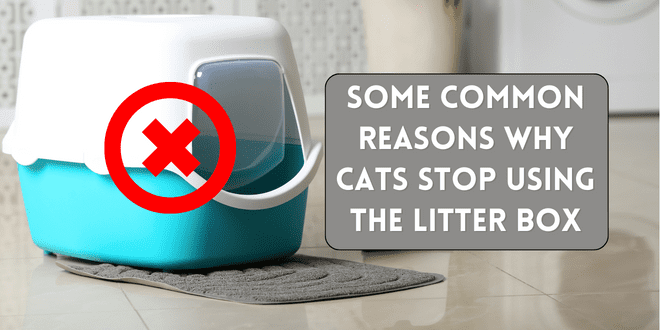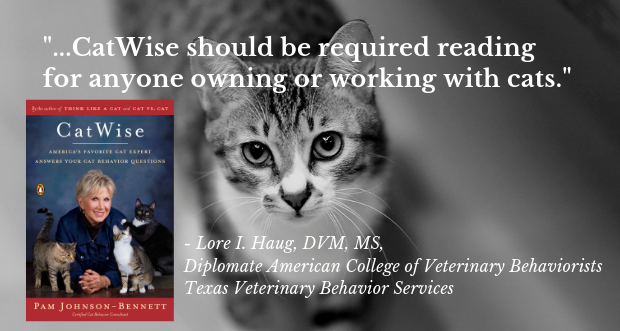Listen to the audio version of this article

When your cat stops using the litter box it’s frustrating and stressful for both cat and cat parent. It’s also, sadly, one of the most common reasons that a cat may get a one-way ticket to the nearest shelter. There are many reasons why a cat may avoid the litter box and it’s important to figure out the true cause in order to get everything back on track. Litter box avoidance shouldn’t be a deal-breaker when it comes to whether kitty gets to stay in your family or not. While some reasons for litter box aversion may be more complex, there are often some simple mistakes cat parents make. If you’re a new cat parent it’s especially easy to make some simple errors that may not seem important at the time but, trust me, those mistakes can have a big effect on how your cat views his toileting set-up. Here’s a list of some common reasons for litter box avoidance.
Underlying Medical Issue for the Cat’s Behavior
When dealing with a litter box problem be sure you look at this possibility first. Don’t assume a problem is behavioral without getting your cat checked by the veterinarian in order to rule out any medical cause. It’s common for a cat experiencing discomfort upon elimination to associate the box with the pain. It may also be that your cat can’t make it to the box in time due to discomfort.
Declawing
Cats who are declawed may continue to feel pain long after the healing period. Some cats’ paws remain sensitive for the rest of their lives and the texture of the litter may be too uncomfortable for them. There are so many reasons not to declaw your cat and this is just one of them. If you’re on the fence about whether to put your cat through this surgical amputation, please first read the article on this website on declawing.
A Dirty Litter Box
Would you want to use a toilet that is never flushed? Of course not. Cats are very clean animals and if the box is too dirty they will seek other arrangements. Scoop the litter box at least twice a day and completely wash out the box monthly. If you’re not using scoopable litter then wash out the box on a weekly basis.
A Covered Litter Box
You may think a covered box is a good idea because it gives the cat some privacy and also confines the litter odor inside the box. The truth is, a covered box isn’t cat-friendly. A covered box often makes the cat feel confined. The covered box makes it more inconvenient for you to scoop on a regular basis (out of sight…out of mind). Covered boxes also create more odor because air doesn’t get in there to dry the soiled litter. My biggest complaint with a covered box is that it prevents the cat from having escape potential. In a multicat household this can be a crucial issue because a cat may avoid the box if he feels he’ll get ambushed while in there.
Wrong Sized Litter Box
Don’t choose a litter box size based on where it conveniently will fit in a location. Choose a box based on the size of your cat. The box should be about 1 ½ times the length of your cat from tip of the nose to base of the tail.
Not Enough Litter Boxes
In multicat homes you should have the same number of litter boxes as you have cats plus one extra for good measure. If there’s a litter box issue, then you really can’t avoid to skimp on the number of boxes. If you live with just one cat but you have a home with more than one level then there should be a box on each level.
Wrong Location for the Litter Box
Location choice should be about convenience and security for the cat and not about what is convenient for the cat parent. Don’t put the litter box near the food, in a damp basement, in a closet or near household appliances that may frighten the cat (such as the washing machine). In a multicat household, scatter boxes around the home and don’t have them lined up in one room. You don’t want a cat developing a litter box aversion problem because he’s afraid to cross the path of another cat in order to get into the one room where all the boxes are located. Place a box in each cat’s preferred area.
Litter Box Liners
Litter box liners are created for the convenience of the cat parent but they often tear from the cat’s claws. It’s also easy for urine to form pools in the folds of the plastic and that creates an odor problem. Since cats are very tactile you also have to keep in mind how the plastic may create discomfort when a cat is trying to dig and cover his waste.
Not Enough Litter in the Box
Don’t be stingy when it comes to filling the litter box. If you don’t want to create an odor problem, put an adequate amount of litter in the box and keep the level consistent. In general, about 3 inches of litter is a good amount. As you scoop, periodically top off the litter with a bit more to keep a consistent amount.
The Wrong Litter
In general, cats like an unscented, sand-like substrate. They like the soft feel on their paws and the sand-like litter makes it easy for digging and covering. Cats also don’t want to smell all the flowery, perfumed litters. Keep in mind how close your cat’s nose will be to the litter when he’s in the box. Texture is also important when it comes to litter. There are so many litters on the market that are created to appeal to the convenience of the cat parent but in many cases they are just a litter box problem waiting to happen. While some cats may prefer the texture of an alternative litter, most prefer an unscented, soft, scoopable litter.
Stress and Environment Affects Your Cat
Whether the stress is due to multicat issues, household chaos or sudden changes (such as a move, renovation, new baby, new spouse, etc.), the effect can end up being litter box aversion. Cats are creatures of habit who don’t adjust well to abrupt changes or chaotic environments. A litter box avoidance problem may be the result of your cat being too fearful to even peek his head out from under the bed. Address multicat tension issues and/or environmental factors in order to provide your cat a sense of security and safety in his own territory.
Going High-Tech with the Litter Box
Electronic self-cleaning boxes have so many downsides that I don’t even know where to start. Many of them have motors that are frightening. Some are so big but the actual surface area for the cat is too small. Many self-cleaning boxes have covers as well. Even though some of these boxes are timed to not activate the cleaning until 10 minutes after the cat has left the box it doesn’t account for another cat entering. Some rakes in the boxes easily clog when there’s a large clump due to diarrhea. The other important downside to a self-cleaning box is that you are prevented from monitoring what is or isn’t happening in the litter box. When you clean the box it’s an opportunity to check on your cat’s health. It’s during cleaning time that you may notice constipation, diarrhea, a larger-than-normal urine clump or no urine clump at all.
Strong Cleansers for Cleaning Litter Boxes
Strong-smelling household cleansers may leave enough of a strong scent on the plastic box that it drives the cat away. When you clean the box use bleach that is heavily diluted in hot water or you can even use dish soap that is very diluted. When you’re done cleaning you don’t want to have any traces of scent on the plastic.
Litter Scatter Mats
These mats are designed to catch the litter that gets trapped on the cat’s paws as he exits the litter box. Some mats may have a texture that cats find uncomfortable.
Punishing Your Cat
I include this on the list because it’s important to know that a cat may avoid the box because he has been punished for eliminating in other locations. When you punish a cat for peeing or pooping outside of the box, the messages he receives are 1) he should be afraid of you, and 2) peeing and pooping will get him in trouble. Even though you think you’re teaching him that his location choice is what you objected to, the message he got was to avoid peeing and pooping when you’re around. Punishment also means you are assuming the cat is misbehaving and in reality, he isn’t. If a cat isn’t using his litter box it’s because he feels he can’t. Your job is to figure out why. Punishment is inhumane and counter-productive.
Need More Information?
For more specific help when it comes to setting up a litter box or dealing with litter box aversion issues, refer to any of the books by best-selling author Pam Johnson-Bennett. Her books have been called the “cat bibles” by veterinarians, behavior experts and cat parents worldwide. You can purchase Pam’s books at bookstores and online. We’ve included links to Amazon here on our website.
If you have a question about your cat’s behavior or health, contact your veterinarian. This article is not intended as a medical diagnosis nor is it a replacement for your cat’s regular veterinary care. This article is for general information purposes only.





